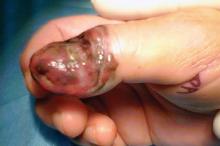A man went to his primary care physician 3 months after slamming his right thumb in a car door. The nail had turned black and sloughed off several weeks later, leaving a red, draining wound on the tip of his thumb. The wound drained continuously for the next 2 months and showed little progress in healing.
His physician started him on antibiotics, but the wound still showed no progress in healing over the next 6 weeks. Cultures were obtained that grew out Staphylococcus and Streptococcus spp. Another course of antibiotics was given, but the patient’s condition failed to improve.
At this point the patient was referred to a surgeon. He missed several appointments before finally presenting to the surgery clinic nearly 6 months after his original office visit. He was diagnosed clinically as having a giant pyogenic granuloma and was given antibiotics as well as silver nitrate sticks to cauterize the wound daily. After missing several more follow-up appointments, the patient returned with a spongy, weeping soft-tissue wound over the dorsum of his right thumb [that] doubled in size over the past 3 months (FIGURE). Radiographs obtained at that time were normal, but a bone scan revealed late uptake, cause for concern that this was osteomyelitis.
FIGURE
Ulcerated tip of the thumb
What is the differential diagnosis, and what tests are necessary?


